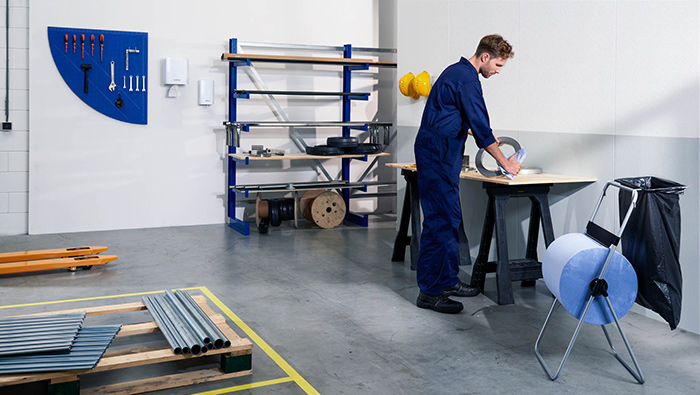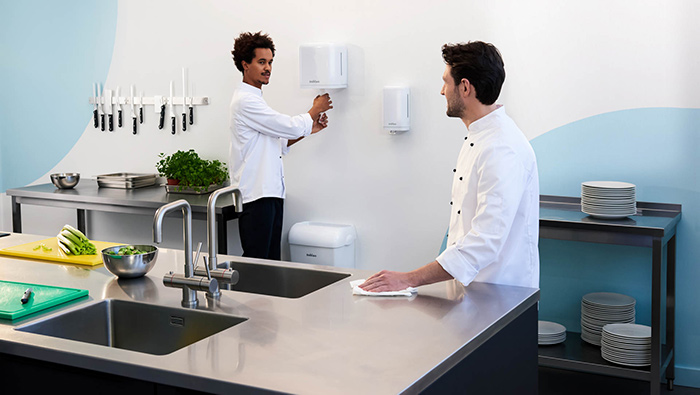Creating Environments That Care
 Mental wellbeing is becoming increasingly important to employers looking to grow their teams and maintain a competitive edge. Here, Alasdair Sharp - UKI Sales Manager at Satino by WEPA, shares his tips on how facilities managers can integrate mental wellbeing into their hygiene strategies.
Mental wellbeing is becoming increasingly important to employers looking to grow their teams and maintain a competitive edge. Here, Alasdair Sharp - UKI Sales Manager at Satino by WEPA, shares his tips on how facilities managers can integrate mental wellbeing into their hygiene strategies.
Care is a fundamental part of workplace wellbeing. Creating a caring environment helps businesses to enhance brand reputation, reduce sick days, retain and grow their staff team and increase productivity. It’s quite simple – when we feel cared for, we care more about the work we produce. Ensuring staff are operating in a clean and hygiene-conscious environment should be a prerequisite for any caring workplace. Facilities managers should be implementing hygiene strategies that support this, but it can be hard to know where to start. Below are some key considerations for any hygiene strategy built around wellbeing.
Keeping Your Washroom Fully Stocked
When considering a hygiene strategy, washrooms are a great place to start. As supply chain pressures continue to mount, some hygiene suppliers may struggle to meet demand. Making sure you’re working with a supplier that will allow your washroom to be fully stocked with soaps, cleaning supplies, toilet paper, hand towels and disinfectants, is crucial to maintaining your washroom facilities. A company that doesn’t provide staff with the basics will struggle to establish itself as an employee that cares.
Sanitisation On The Go

While washrooms are a great place to start, your hygiene strategy shouldn’t stop there. Installing hand sanitiser stations throughout the building is a strong visual that will help staff feel at ease. This is particularly important in fast-paced, customer-facing environments, such as hotels and restaurants which see staff on their feet all day, as it allows them to sanitise their hands on the go. This leads to fewer sick days and enhanced infection control. In fact, research shows that hand hygiene can be directly influenced by the visibility and accessibility of dispensers.
Using Technology To Beat Infection
Installing hygiene technology is a great way of minimising the spread of infection, as well as communicating to staff that their health is worth investing in. Hands-free technology, including sensor-operated taps, soap dispensers and toilet flushers, is a good place to start. Not only does this mean fewer touch points for staff using the facilities, sensor-operated dispensers also require fewer refills than manual alternatives, meaning savings to your bottom line and a reduced workload for cleaners and the facilities team.
Communicating Care

Working in stressful environments such as restaurants, hotels and care homes will see staff burdened with huge mental workloads. For those concerned about the risk of infection, setting out clear communications to all staff can help take a massive weight off. Ensuring graphics are placed around areas such as kitchens, washrooms, staffrooms and meeting areas, will underpin the message of care, whilst also reminding employees to check in on their own hygiene.
Employee Feedback
This may seem like an obvious measure but it’s one that is so often overlooked. Asking staff for their feedback on the sort of hygiene measures they would like to see is a highly effective way of creating a caring environment. What’s more, staff are best placed to know the hygiene challenges that they face on a day-to-day basis, making it an valuable way of minimising the spread of infection and promoting employee wellbeing.
Facilities managers can play an important role in the journey to workplace wellbeing by simply recognising the link between hygiene and mental health. Ensuring that the teams in your building know that hygiene is a top priority, as well as listening to their needs and wants, can do wonders for their wellbeing. Once you’ve cracked this, you will be sure to see a happier and healthier workforce.


























































